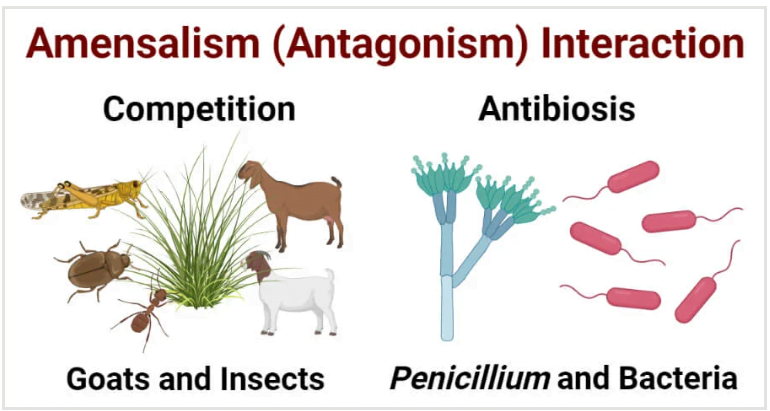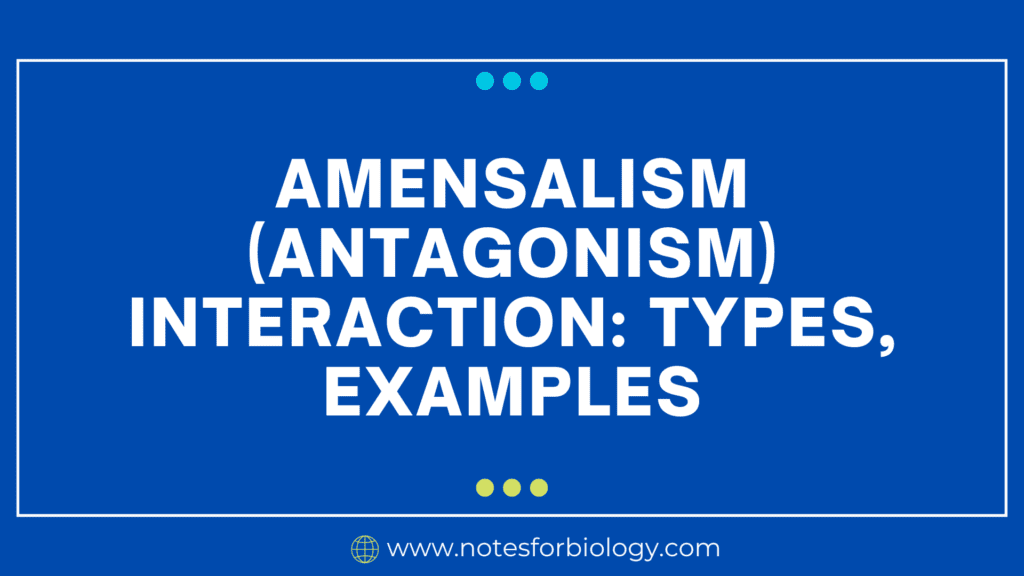Amensalism Interaction, is a biological interaction in which one organism is prevented from existing or is destroyed while the other is left undisturbed. This interaction is commonly observed in both artificial and natural contexts, and it can happen through a variety of processes. Amensalism influences species interactions and preserves ecological balance, which in turn shapes the dynamics and structure of communities.
Table of Contents
What is Amensalism Interaction?
Amensalism Interaction is a form of adverse ecological interaction in which one species suffers injury or extinction while the other either survives or thrives.

Types of Amensalism
There are several types of Amensalism Interaction based on the mechanisms involved:
1. Competition-based Amensalism:
A sort of ecological interaction known as competition-based Amensalism occurs when one organism outcompetes another for resources like nutrition, light, or space, causing indirect harm to the latter without any direct touch. The superior competitor in this relationship controls the resources, preventing the other organism’s development, survival, or reproduction.
Example: In a forest, taller trees may shade out smaller plants, depriving them of the sunlight needed for photosynthesis and stunting their growth.
2. Chemical-based Amensalism (Allelopathy):
Chemical compounds that impede the growth, survival, or reproduction of other species are produced and released by one organism. These substances have the potential to harm neighboring organisms when they are released into the soil, air, or water.
Example: Black walnut trees (Juglans nigra) produce juglone, is harmful to many other plants, preventing them from growing or surviving in the walnut tree’s immediate vicinity.
3. Physical Suppression:
Physical suppression is a type of Amensalism in which an organism physically hurts or suppresses another, usually by mechanical methods, leaving the suppressing organism untouched. The inhibited organism’s capacity to grow, reproduce, or survive may be destroyed as a result of this interaction.
Example: Elephants and other large animals have the ability to physically harm and impede the growth of smaller plants and organisms by trampling and destroying them as they travel through an area.
4. Microbial Antagonism:
Certain chemicals that are produced by microbes prevent other microorganisms from growing or surviving. In the context of antibiotics and antimicrobial substances, this kind of interaction is frequently seen.
Example: Penicillin, an antibiotic that prevents the growth of some bacteria, is produced by the mold Penicillium. While the bacteria are suppressed or eliminated, the Penicillium mold remains untouched.
5. Environmental Modification:
When one organism modifies the environment, it negatively impacts other organisms. Variations in pH, oxygen concentrations, and other environmental elements can be examples of this.
Example: The pH level of soil can be changed by certain bacteria, which unsuits the habitat for other microbial species that compete with them.
Summary: Based on the mechanisms underlying Amensalism Interactions, these can be roughly classified as follows: microbial antagonism, physical suppression, chemical inhibition (allelopathy), competition for resources, and environmental alteration. By affecting the interconnections and species composition within ecosystems, Amensalism interactions have a substantial impact on the dynamics and structure of communities.
Frequently Asked Questions(FAQ)
What is Amensalism?
Amensalism, sometimes referred to as antagonism, is a form of ecological interaction in which one organism is hindered or eliminated while the other is left undisturbed. Usually, it involves mechanisms like resource competition, physical suppression, or pharmacological inhibition.
What are the main types of Amensalism?
The main types of Amensalism include: Competition-based Amensalism, Chemical-based Amensalism (allelopathy), Physical suppression, Microbial antagonism, Environmental modification.
How does Amensalism differ from other types of interactions?
Amensalism is unique in that it is the wounded organism’s fault and does not benefit or hurt the other. This is not the same as commensalism, where one organism benefits while the other remains unaffected, parasitism, when one benefits at the expense of the other, or mutualism, where both organisms benefit.
Related Articles




